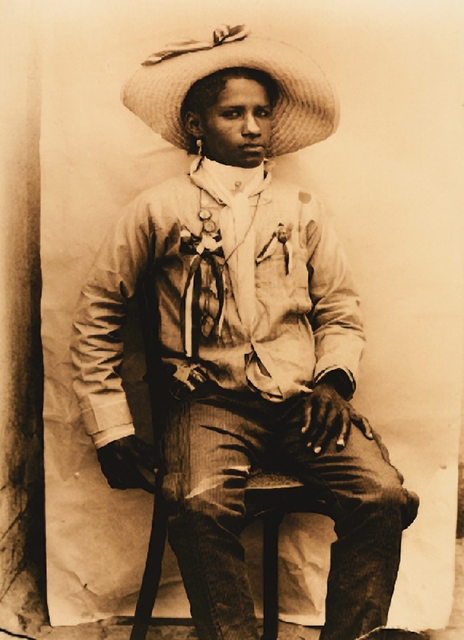The National Hispanic Cultural Center’s newest exhibit, The African Presence in Mexico: From Yanga to the Present, spans five centuries of Mexico’s “third root,” people of African descent. It’s an engrossing and essential exhibit due to the fact that Mexico only officially acknowledged such a legacy in 1992 following the groundbreaking work of anthropologist Dr. Gonzalo Aguirre Beltrán. This impressive show opened on March 30 to a culturally diverse record crowd of over 1,000 people. A visit will be well worth your time and energy.The collection begins with some historical orientation: the history of Africans and their descendants in Mexico since their arrival with the Spanish. Images in maps, 17 th -century texts, silk and watercolor on paper, lithographs, photographs, sculpture and paintings, and bilingual panels offer some fascinating historical data and perspectives. One artifact under glass, a Hopi Chakwaina Katsina figure, reflects the relationship between Southwestern peoples and Esteban de Durantes, the Moorish slave who led the first Spanish explorers into the Southwest. We also learn that between 1580 and 1640, Mexico had the largest African population in the New World.During that same era, the uprising by a self-liberated Afro-Mexican named Yanga in 1609 established the first free African town—San Lorenzo de los Negros—after years of guerrilla warfare with the Spanish. Until emancipation in 1830, cities and towns relied heavily on the work of enslaved Africans and Afro-Mexicans in silver mines and on sugar cane plantations. After emancipation, Afro-Mexicans were not legally segregated as African-Americans were in the United States, and so they blended into the general population, though most Afro-Mexicans reside, even today, in Vera Cruz and Costa Chica. One set of paintings documents the 18 th -century castas system, designed to emphasize Spanish racial supremacy and to warn Mexico’s criollo and the Spanish population to avoid the slide downward that would invariably result from mixing with African and indigenous populations. An anonymous painting in this series features a negra woman, arms akimbo, with her mulatto child at her skirts. She’s chastising, we are to assume rather loudly, her Spanish partner in the threshold of their kitchen door. The piece serves as a warning about the tongue lashings that would result from such a match. Though intense and overwhelming, the historical perspective in the first room provides both a lens through which we experience the entire collection and a mirror into which we see our common reflection in African-descended cultures in the Americas. Notorious Francophile Porfirio Diaz, Mexico’s leader at the time of the revolution, attempted to erase the contributions of Afro-Mexican and indigenous folks from Mexico’s history, but Emiliano Zapata formed alliances with battalions of Afro-Mexicans during the Mexican revolution, including battalions from Guerrero made up of widows who became soldiers.An enormous and stunning photograph by Augustin Casala captures one of Zapata’s allies: A soldier from Michoacán sits in a high-backed cane-bottom chair, pistol in her pants on the right, her shirt decorated with ribbons and medals. She gazes from under her huge hat, steadfast and fierce, straight into the eye of the camera. Black and white photographs offer a window into the regularity of the lives of Afro-Mexican people as cane pickers, barbers, brides and grooms. Continuing along this journey, you will find more amazing photographs, musical instruments, ceremonial costumes, woodcuts, paintings, installations and movie posters, all documenting Afro-Mexican culture until current times. A dancer’s coyolillo costume from Veracruz, complete with bull head, mirrors and strips of colored cloth, is reminiscent of Caribbean Carnaval . African-Americans Elizabeth Catlett and Margaret Burroughs are among the few women represented, and several panels describe the relationship between the great Mexican muralists and Harlem Renaissance artists.For the next several months, you can bear witness to this art and history, any day of the week except Monday. And while you’re there, get yourself a calendar of related community events that includes a local exhibit on New Mexico’s African-American legacy , a photography exhibit, a multimedia performance piece, a slide lecture and a culinary demonstration. This citywide collection of events and exhibits represents the kind of culture that, in the words of the center’s executive director Eduardo Diaz, “creates a common table where everyone can pull up a chair.”
The African Presence in Mexico: From Yanga to the Present runs through Aug. 5 at the National Hispanic Cultural Center (1701 Fourth Street SW). 246-2261.




